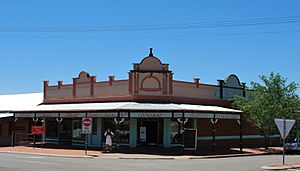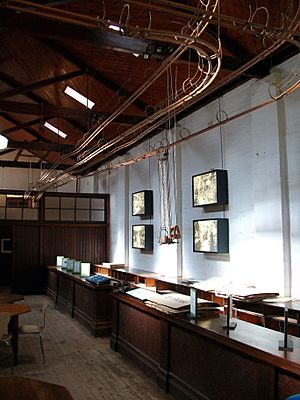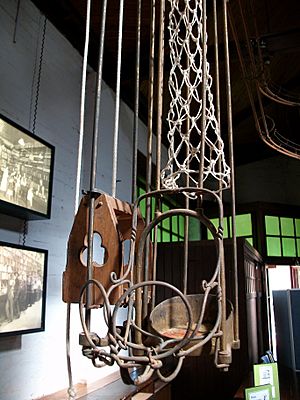Up-To-Date Store facts for kids
Quick facts for kids Up-To-Date Store and Garth Jones Collection of farm machinery |
|
|---|---|
 |
|
| Location | 127-129 Cowabbie Street, Coolamon, Coolamon Shire, New South Wales, Australia |
| Built | 1909–1909 |
| Architect | William John Monks |
| Owner | Coolamon Shire Council |
| Official name: Up-To-Date Store and Garth Jones Collection of farm machinery; Up To Date Store | |
| Type | state heritage (built) |
| Designated | 13 October 2006 |
| Reference no. | 1761 |
| Type | Shop |
| Category | Retail and Wholesale |
| Builders | George Henry Mutch |
| Lua error in Module:Location_map at line 420: attempt to index field 'wikibase' (a nil value). | |
The Up-To-Date Store is a special old building in Coolamon, Australia. It used to be a shop but is now a museum. Inside, you can find the Garth Jones Collection of Farm Machinery. This historic store was designed by William John Monks and built in 1909. Today, the Coolamon Shire Council owns it. It was added to the New South Wales State Heritage Register on October 13, 2006, because it's a very important part of history.
Contents
A Look Back: The Store's Story
The Up-To-Date Store's story is closely linked to how Coolamon town grew. It's also connected to the big wheat farming industry in the area. From 1909 to 1932, the store sold tools and household items to farmers. It also bought wheat and other crops from them. The store did well when farming was strong. But it closed in 1932, during the worst part of the Great Depression.
How Coolamon Town Grew
Coolamon became a town on October 3, 1881. This happened because a railway line was built from Junee to Narrandera. This railway helped open up the southwestern parts of New South Wales for growing wheat. Coolamon started as a small railway stop. At first, the railway station helped a busy timber industry. But soon, wheat farming became the main reason Coolamon grew.
Wheat production greatly increased between 1903 and World War I. This was thanks to better wheat types and new farming methods. In 1905, over 100,000 bags of wheat were sent from Coolamon railway station. Coolamon's population tripled in 20 years, reaching about 600 people by 1906. The main street, Cowabbie Street, was very wide (60.3 meters). This was to make room for the large wheat wagons. Shops, hotels, and offices lined Cowabbie Street. The town had to rebuild often because of big fires in 1912 and 1918.
The Store's Early Days
The land where the Up-To-Date Store stands was bought by Nicholas Mutton in 1908. His family owned it until 1987. Coolamon Shire Council bought it in 1998. The people who ran the store from 1909 to 1932 did not own the building. They rented it from the Mutton family.
A shop has been on this spot since 1883. By 1893, it was a wooden building run by Frederick Hall. It was called the "Up To Date Store" in ads, even if the name wasn't on the building. "Up to date" was a common phrase back then for new and modern things.
In 1907, Harold Charles Nadin, F. Alcock, and William Denoon took over Hall's store. Nicholas Mutton bought the land in 1908. He then leased the property to Nadin, Alcock, and Denoon.
Building the New Store
Nicholas Mutton likely decided to build the new Up-To-Date Store. This might have been because a fancy new brick store was built nearby in 1907. Hall's old wooden shop couldn't compete with this modern building. So, the idea was to make the Up-To-Date Store truly "up to date." They even added cool new features like a Lamson Cash Carrier system.
Work on the new store began in January 1909. George Henry Mutch was the builder. By July 1909, the new store was finished. W.A. Iverach had joined Nadin and Denoon in the business. The new building was made of brick, likely from local brick kilns.
The architect, William John Monks, was very famous in country New South Wales. He designed many buildings, including hospitals and cathedrals. The builder, George Henry Mutch, ran a timber business in Junee. The local newspaper even praised the sign-writing on the new store.
Who Ran the Store?
- Nadin, Iverach and Denoon (1909-1912): William Alfred Iverach, known as 'W.A.', started working at Hall's store in 1896. He worked his way up and eventually partnered with Nadin. In 1909, he bought Alcock's share in the Up-To-Date Store. The local paper praised the new store, calling it "truly up-to-date" with modern features.
- Nadin, Iverach and Wilson (1912-1914): William Denoon left in 1911, and Hugh Charles Wilson joined.
- Nadin and Iverach (1914-1925): Wilson sold his share in 1914. Nadin and Iverach became agents for farm machinery companies like H. V. McKay Sunshine. W.A. Iverach continued to sell farm equipment for many years.
- W.A. Iverach (1925-1932): In 1925, W.A. Iverach took over the store by himself. He ran it until December 1932. Then, he moved his business to a larger store nearby.
What Happened After 1932?
After the store closed in 1932, the Mutton family used the building for storage. They stored hay, grain, fencing, and machinery. They also made some changes to the building, like adding a corrugated iron extension. The old stables were replaced with a workshop that had a blacksmith's forge.
The store was also used for other things over the years. People roller skated there, and it was even a fruit shop for a while. Today, the building is a museum and also houses the Coolamon Library.
What the Store Looks Like
The Up-To-Date Store is on a corner where Cowabbie and Loughnan Streets meet. It has two main fronts facing the streets. There's a wide, wrap-around porch (verandah) with a corrugated iron roof. The building is made of brick with a timber roof.
The top part of the building, called the parapet, has fancy decorations. It has smooth panels for signs and a curved shape in the middle. The date "1909" is at the very top. The corner of the building is angled, with the main entrance there. This corner is a key feature of the building's design.
The store is an example of the Federation Free Style of architecture (popular from 1890 to 1915). This style often has:
- A noticeable skyline, especially at the corner.
- Strongly different materials or colors, like brick and smooth plaster.
- Curved shapes in the parapet.
- Fancy designs on the verandah post brackets.
Inside, the store has two large main rooms. There are also three smaller rooms and a short hallway at the back. The walls are painted brick and timber. The floors, counters, and shelves are all made of timber.
A really cool feature inside is the Lamson cash ball system. This old system used hollow wooden balls that rolled down tracks. Money from the counters would be put into a ball and sent to an office. There, change would be given and sent back to the counter. This system is not working now, but it's still mostly there. It's very rare to find one still in its original place!
The Farm Machinery Collection
The sheds behind the main store building hold the Garth Jones Collection of farm machinery. This is one of the best collections of its kind in New South Wales. It includes:
- Farm equipment
- Wagons and sulkies (light two-wheeled carts)
- Fences and gates
- A wooden water trough
- A plough
- A wheat pickler (for treating seeds)
- A windmill
- A water cart
- Horse and bullock harnesses
- Other tools
The two wagons in the collection are especially impressive. They are in amazing condition and still have most of their original paint. This collection is special because most items are in their original state. They also come with detailed records and photos from Garth Jones's family farms in the Coolamon area. Garth Jones himself shared stories about working on the land, which makes the collection even more meaningful.
This collection shows important parts of farming history in the area. It covers topics like water, clearing land, using animal power, growing wheat, fencing, and transport. It also helps us understand the kind of farming businesses the Up-To-Date Store served.
Why the Store is Important
The Up-To-Date Store is very important to the history of New South Wales. It's a great example of a medium-sized country general store from the early 1900s. It's amazing how much of the original store, built in 1909, is still there.
The old shop fittings, like the counters, shelves, and the open layout of the rooms, help us understand how a country store worked. The Lamson Cash Carrier system is especially rare. It's the only one known in New South Wales that is still in its original spot.
The Garth Jones Collection of farm machinery is also very important. It's one of the best collections of its kind in the state. It shows the strong link between the store and the farming community. The store provided farmers with what they needed, and the collection shows the tools they used. The collection is special because it's mostly original, well-documented, and comes from the Coolamon area. It tells stories about rural life, like how farmers used water, cleared land, and transported goods.
The Up-To-Date Store and the Garth Jones Collection were added to the New South Wales State Heritage Register on October 13, 2006. This means they are protected because they are important for:
- Showing history: They help us understand the history of trade and farming in New South Wales.
- Connecting to important people: People like Frederick Hall, W.A. Iverach, and Nicholas Mutton were important to Coolamon's growth. The architect, William John Monks, was also a well-known designer.
- Being beautiful and well-designed: The store's design adds a lot to the look of Coolamon's main street. It's a good example of the Federation Free Style of architecture.
- Being important to the community: The store is a special part of Coolamon's memory. Local groups have worked hard to save and use it.
- Teaching us new things: The store and the collection offer rare clues about how country stores and farming worked in the early 1900s.
- Being rare: The store is very well-preserved for its age. The Lamson Cash Carrier system is extremely rare, and the Garth Jones Collection is one of the best and most complete of its kind.
- Showing typical examples: The store is a great example of a country general store from its time. The farm machinery collection is a top example of its type.
Images for kids





